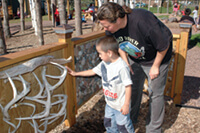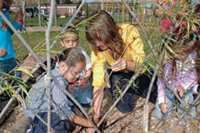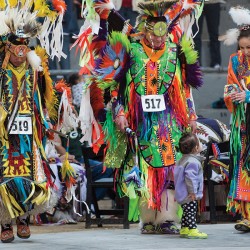Driven by Data

A playground with cultural features — and plenty of room to play and exercise — came to fruition as UW researchers worked closely with families at the Bad River reservation. Photo: Rick Oliva
UW researchers help Wisconsin tribes fight obesity on their own terms.
When Alexandra Adams came to the UW ten years ago, her credentials included a growing interest in Indian health. The assistant professor of family medicine had previously worked at tribal health centers in Wisconsin, Alaska, and South Dakota, and she hoped to address diabetes prevention among American Indian tribes.
She soon learned that health fairs held on the Bad River reservation in northern Wisconsin included screenings for body mass index and blood sugar — a good start for exploring the epidemic levels of obesity, heart disease, and diabetes found among the state’s tribes. Adams, who also has a PhD in nutrition, discovered that the exams were designed to guide individual lifestyle changes, but no one was collecting and analyzing the data to get a solid overall picture of the community.
“The people who showed up at the health fair were parents with little kids, and they asked us to screen them, so we ended up looking at one hundred kids,” recalls Adams. “When we brought those data back to the tribe in Bad River, they were shocked: 26 percent of kids aged five to seven were obese, and many had early heart-disease risk factors.”
Data and a willingness to listen became the springboard of a long-term effort among Adams’s research group and several tribes to abate obesity-related diseases. In 2001, the National Institutes of Health (NIH) began to support the Wisconsin Nutrition and Growth Study (WINGS), a partnership among the UW Department of Family Medicine, the Great Lakes Inter-Tribal Council, and the Bad River, Lac du Flambeau, and Menominee tribes to study risk factors for heart disease and diabetes among five hundred Indian children.
“The high rate of overweight and obesity in young children was creating early heart-disease risk factors, but people were not connecting dots, and did not realize that the early life influences were leading to high rates of disease later on,” Adams says.
Her interactions with the tribes represent “community-based participatory research,” which engages the community in setting goals and fully participating in the research. “I don’t come in as an outsider telling communities what to do,” she says. “I say, ‘I am a physician with an interest in preventing these chronic diseases. I know nutrition is a strong component. How can I help?’ ”
Adams and her collaborators have developed the Healthy Children, Strong Families project, a randomized trial of a healthy- lifestyle intervention for families with children ages two to five. A grant to the Great Lakes Inter-Tribal Council from the Wisconsin Partnership Fund jump-started the effort; in 2006, it gained support from NIH.
Four years later, data show that the adults are controlling or reducing their weight; numbers for the children are just being tabulated. “At this point, we can’t say [the project] has reduced excess child weight gain,” Adams says, “but it has brought attention to the issue and has led to a number of community-driven, child-focused initiatives.”
Under the project, each reservation has an advisory board that identifies barriers to healthy lifestyle behaviors and ways to tackle changes. The Bad River board decided to emphasize exercise by building a natural playground. Samuel Dennis, Jr., a UW landscape architecture professor, worked with the tribe to design a space that used cultural influences, such as a canoe used to harvest rice and a willow lodge.
“The incorporation of our tribal culture is what sets this project apart from other playground projects,” says Mike Wiggins, Jr., Bad River tribal chair.
“When you work directly with the community to design a community space or a park,” Dennis says, “it’s not just a better design, but because people … had a meaningful hand in the design and construction, they get a stronger emotional attachment.”
The Menominee reservation’s advisory board chose to focus on healthy food. “The reservations are what we call a ‘food desert,’ with low levels of fruit and vegetable consumption because you can’t find any,” Adams says.
The board has created eight community and forty-seven individual vegetable gardens, and is promoting other lifestyle changes, including occasionally dropping children off the bus a distance from their school, to encourage walking.

The UW “participatory research” is planting seeds — both literally and figuratively — for change, involving the community in healthier behaviors to reduce obesity, heart disease, and diabetes. Photo: Rick Oliva
“The more you can engage people in discussions about healthy behavior, the more it sticks,” says Jerry Waukau, the reservation’s tribal health director.
Adams and her tribal partners expect further collaborations aimed at preventing childhood obesity and chronic disease as they build on what they have learned so far.
“We recognize that reducing heart disease and diabetes will take years,” Adams says, “but we are planting seeds in partnership with the community. Sometimes we are at the forefront. Sometimes we are only giving information. Sometimes we are walking alongside.”
Published in the Winter 2010 issue



Comments
Steve Tomasko January 26, 2011
I believe you may have the wrong name for the photo credits that go along with this story. His name should be Rick Olivo.